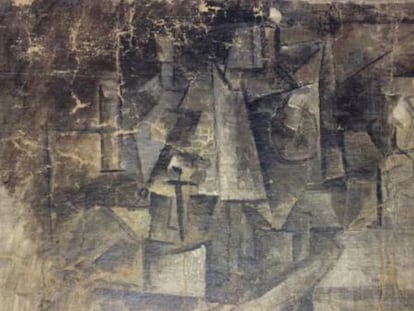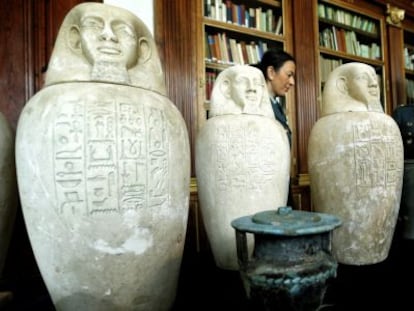Plot thickens in tale of nuns, missing art and a spat between Catalonia and Aragón
A crib on sale at auction alerted authorities to the irregular movement of a monastery’s valuables


The plot to the Sijena story thickens. First the regional governments of Catalonia and Aragón were involved in a lawsuit concerning the sale of Romanesque murals from the Santa María de Sijena monastery, in Huesca province, to Catalan authorities. Catalonia claims the 1936 transfer saved the valuable artwork from destruction during the Spanish Civil War, while Aragón says it amounted to plunder.
Now it appears that 23 religious artifacts from the Sijena monastery registered with the Catalan government’s Department of Culture have changed hands without the nuns informing the authorities, as they were legally obliged to do. This conduct could be penalized with a fine of €138,000.
Just when it seemed no more would be heard about the missing items, a small silver crib turned up at a Barcelona auction
In the early 1970s, 120 valuables were taken out from the Huesca monastery by the nuns, who traveled to Catalonia and left the religious artwork “in custody” with Barcelona’s municipal art museums. An agreement signed by convent prioress Angelita Opi and museums director Joan Ainaud Lasarte stipulated that the sisters could take these items back at any time.
In 1983 and 1992, the religious community sold 97 of these pieces to the Catalan government for close to €300,000, and the latter put them on display inside Lleida Museum and Catalonia’s National Museum of Art (MNAC).
However, a recent ruling by a Huesca court has ordered the return of these heirlooms to the government of Aragón. Catalonia has returned 53 so far, but the other 44, generally considered the most valuable, are still on show in Lleida.
As for the remaining 23 items that were not sold, in 1993 the sisters asked to take them back, citing sentimental reasons. The Catalan government obliged, but first registered them as cultural assets, a move that meant the nuns were bound to inform the authorities if the artifacts ever changed hands again.
But the convent that they were taken to in 1993 has been closed since 2007, and nobody knows where the 23 pieces went. The religious community is keeping quiet.
A shared history
Aragón and Catalonia share historical ties, as they were both once part of the Crown of Aragon, a confederation of territories that existed for hundreds of years and reached its apex in the 13th and 14th centuries.
Catalan is spoken in a strip of eastern Aragón that borders on Catalonia, and known as La Franja.
According to cultural heritage laws, this kind of misconduct could mean a fine of €6,000 for each relic, amounting to a total of €138,000, which the religious order will have to pay if the Catalan government presses ahead with sanction proceedings. “We are studying the case,” says a government spokesperson. “At some time in the future, a decision will be made.”
Among the religious artwork recovered by the nuns, there are reliquaries containing what is believed to be a piece of Jesus’s cross and a sliver of John the Baptist’s cross, two silver ceremonial staffs (one with the Good Shepherd and two angels and the other with a crucifix), two Eucharistic boxes, three ceramic platters, two spoons, a jug, a book cover, and an ivory ornament of the baby Jesus, his silver crib and various other elements of the Nativity scene, also in silver.

But just when it seemed the Catalan government would hear no more about the 23 objects, the small silver crib, made in the late 16th or early 17th century, turned up at an auction this year with a starting price of between €10,000 and €12,000. To boost its value, the auction house had mentioned its cultural heritage credentials. This alerted the Catalan Department of Culture, which sent in the police to order its removal from the auction house.
However, the crib is now in the hands of the Aragonese government: in January, a Huesca judge sent the judiciary police to remove it from its new owners’ Barcelona home – and failed to inform the Catalan government. This in turn prompted a formal complaint from Catalan culture officials to Spain’s Interior Ministry, which has yet to reply.
Additional irregularities
The crib is just one example of how the Sijena monastery artwork has been changing hands irregularly. The nuns ignored cultural heritage legislation when they failed to inform authorities about their decision to transfer the art from Aragón to Catalonia, or about its partial sale in 1983, 1992 and 1994.
They also failed to tell anyone that the silver crib – and possibly the entire remainder of the 23 assets they demanded back in 1993 – ended up in the hands of a private individual, Pilar Alcalde Bretón – the mother of the person who tried to auction off the crib earlier this year – in return for having helped the nuns out financially.
Sign up for our newsletter
EL PAÍS English Edition has launched a weekly newsletter. Sign up today to receive a selection of our best stories in your inbox every Saturday morning. For full details about how to subscribe, click here.
On the other hand, investigators believe that some of these 23 pieces may have been sent to the convent the nuns have in Salinas de Añana, in the Basque province of Álava, where the order’s Mother Superior Virginia Calatayud resides.
At the trial over the Romanesque paintings, Mother Superior Calatayud declared that the Añana convent is the heir to Sijena, and that they would like to recover the murals from Catalonia’s National Art Museum. Asked by EL PAÍS to comment on the case, Calatayud said, “I have nothing to say on the subject.” And then she hung up.
English version by Heather Galloway.
Tu suscripción se está usando en otro dispositivo
¿Quieres añadir otro usuario a tu suscripción?
Si continúas leyendo en este dispositivo, no se podrá leer en el otro.
FlechaTu suscripción se está usando en otro dispositivo y solo puedes acceder a EL PAÍS desde un dispositivo a la vez.
Si quieres compartir tu cuenta, cambia tu suscripción a la modalidad Premium, así podrás añadir otro usuario. Cada uno accederá con su propia cuenta de email, lo que os permitirá personalizar vuestra experiencia en EL PAÍS.
¿Tienes una suscripción de empresa? Accede aquí para contratar más cuentas.
En el caso de no saber quién está usando tu cuenta, te recomendamos cambiar tu contraseña aquí.
Si decides continuar compartiendo tu cuenta, este mensaje se mostrará en tu dispositivo y en el de la otra persona que está usando tu cuenta de forma indefinida, afectando a tu experiencia de lectura. Puedes consultar aquí los términos y condiciones de la suscripción digital.
More information
Últimas noticias
Alain Aspect, Nobel laureate in physics: ‘Einstein was so smart that he would have had to recognize quantum entanglement’
Imelda Castro, the woman who wants to rule the cartel battleground of Sinaloa
The new victims of the Republican war on Obamacare: Millions hit by soaring health insurance premiums
A country divided on migrant rights: Some US states expand protections while others restrict them
Most viewed
- David King, chemist: ‘There are scientists studying how to cool the planet; nobody should stop these experiments from happening’
- Reinhard Genzel, Nobel laureate in physics: ‘One-minute videos will never give you the truth’
- Oona Chaplin: ‘I told James Cameron that I was living in a treehouse and starting a permaculture project with a friend’
- Sinaloa Cartel war is taking its toll on Los Chapitos
- Mexico completes its trade shift with the entry into force of tariffs on China and countries without trade agreements










































